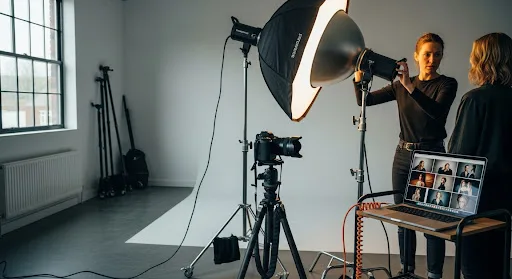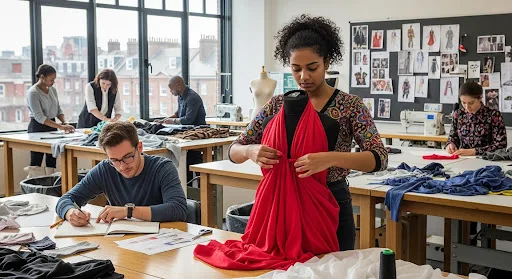Introduction
Whether you’re a designer, developer, photographer, or creative professional, your portfolio is your most powerful marketing tool. Yet many talented individuals struggle to secure opportunities simply because their portfolio fails to communicate their true capabilities. Understanding what your portfolio must include isn’t just about showcasing your best work—it’s about telling a compelling story that resonates with potential clients and employers.
In today’s competitive UK job market, where creative industries contribute over £126 billion to the economy, a well-crafted portfolio can be the difference between landing your dream role and being overlooked. This comprehensive guide will walk you through every essential element your portfolio needs, backed by industry research and practical examples that work in the British market.
Why Your Portfolio Matters More Than Ever
The Changing Landscape of Professional Portfolios
The digital transformation has fundamentally altered how professionals present themselves. Gone are the days when a simple PDF or physical folder would suffice. According to research from the Creative Industries Federation, 87% of UK hiring managers now review online portfolios before even reading a CV.
Your portfolio serves multiple critical functions: it demonstrates your technical skills, showcases your problem-solving abilities, reveals your creative process, and proves you can deliver results. More importantly, it provides tangible evidence of your claims—something a CV simply cannot do.
First Impressions in the Digital Age
Studies show that recruiters spend an average of just 6-8 seconds on an initial portfolio review. This means every element must work strategically to capture attention and communicate value immediately. Understanding what your portfolio must include starts with recognising that you’re not just displaying work—you’re crafting an experience.
The Core Components: What Your Portfolio Must Include
1. A Clear Professional Identity
Your Header and Introduction
The very first section of your portfolio must establish who you are and what you do. This isn’t the place for vague descriptions or clever wordplay. Include:
- Your full name and professional title: Be specific. “Freelance UX Designer specialising in fintech applications” works better than “Creative Problem Solver.”
- A professional photograph: UK professionals respond well to personal connection. Use a high-quality, approachable headshot.
- A compelling tagline: Sum up your value proposition in 10-15 words.
- Contact information: Make it obvious how to reach you—email, phone, LinkedIn, and location.
Your Professional Biography
This 150-200 word section should cover your background, specialisations, and what makes your approach unique. Avoid generic statements like “passionate about design.” Instead, focus on concrete achievements and your working methodology.
For example: “Based in Manchester, I’m a brand identity designer with eight years’ experience helping B2B technology companies clarify their market positioning. I’ve worked with 40+ clients across the UK and Europe, including three successful rebrands that resulted in measurable increases in customer engagement.”
2. Your Best Work—Strategically Selected
Quality Over Quantity
One of the most common portfolio mistakes is including too many projects. Research from design agencies suggests that 6-12 carefully selected projects perform significantly better than portfolios with 20+ pieces.
Each project you include should:
- Represent work you genuinely want to do more of
- Demonstrate different skills or problem-solving approaches
- Be relevant to your target audience
- Showcase measurable results where possible
Project Case Studies: The Essential Format
For each portfolio piece, what your portfolio must include is context, not just visuals. Structure each case study with these elements:
Project Overview
- Client name (or “Confidential Client” if under NDA)
- Project type and duration
- Your specific role
- The core challenge or objective
Process and Approach
- Initial research or discovery phase
- Strategic decisions you made
- Challenges encountered and how you solved them
- Tools and methodologies used
Visual Documentation
- High-quality images or mockups
- Before/after comparisons where relevant
- Detail shots showing your craftsmanship
- Multiple angles or use cases
Results and Impact
- Quantifiable outcomes (increased conversions, user engagement, sales, etc.)
- Client testimonials or feedback
- Awards or recognition received
- Long-term impact if known
3. Demonstrable Skills and Expertise
Technical Proficiencies
List your technical skills clearly, but avoid the common mistake of simply listing every tool you’ve ever touched. Instead, categorise your skills by proficiency level:
Expert Level: Tools you could teach others to use Advanced: Technologies you use regularly with confidence Working Knowledge: Skills you can apply effectively with occasional reference
For UK creative roles, according to sector reports, employers particularly value professionals who can articulate not just what tools they know, but how they apply them strategically.
Soft Skills with Evidence
Rather than claiming you’re a “great communicator” or “team player,” demonstrate these qualities through your case studies. Show how you:
- Collaborated with cross-functional teams
- Presented ideas to stakeholders
- Incorporated feedback constructively
- Managed client relationships
4. Professional Experience and Timeline
Career Progression
What your portfolio must include is a clear narrative of your professional development. This doesn’t need to be as detailed as your CV, but should show:
- Current position and key responsibilities
- Previous roles (past 5-10 years)
- Notable clients or projects
- Career transitions and reasons for them
Education and Certifications
List relevant qualifications, particularly those recognised in the UK market:
- University degrees (institution and classification)
- Professional certifications (e.g., Adobe Certified Expert, AWS certifications)
- Relevant courses or training programmes
- Industry memberships (e.g., Chartered Society of Designers)
According to UCAS data, UK employers place significant value on formal qualifications combined with demonstrable practical experience.
5. Testimonials and Social Proof
Client Testimonials
Third-party validation dramatically increases portfolio credibility. Include 3-5 testimonials that:
- Come from recognisable companies or respected professionals
- Mention specific skills or results
- Include the person’s name, title, and company
- Are recent (within the past 2-3 years)
Avoid generic praise like “Great to work with!” Instead, seek testimonials such as: “Sarah’s rebrand increased our website conversions by 34% within three months. Her strategic approach to visual identity transformed how our clients perceive our business.”
Recognition and Awards
If you’ve received industry recognition, feature it prominently:
- Design awards (D&AD, Creative Circle, etc.)
- Competition wins
- Published work or features
- Speaking engagements or workshops delivered
6. Your Working Process
Behind the Scenes
Many portfolio reviewers want to understand how you think and work. Consider including:
- Sketches or initial concepts
- Mood boards or inspiration sources
- Iteration examples showing design evolution
- Your typical project workflow or methodology
This transparency builds trust and helps potential clients understand what working with you will be like. For agencies and employers, seeing your process confirms that you can work systematically, not just produce attractive end results.
What Your Portfolio Must Include: Format and Presentation
Platform Selection
Website Portfolio vs. PDF
In the UK market, a dedicated website portfolio is now the expected standard for most creative and digital roles. Platforms like:
- Self-hosted WordPress: Maximum flexibility and customisation
- Portfolio-specific platforms (Adobe Portfolio, Behance, Dribbble): Quick setup with industry recognition
- Custom-coded sites: Demonstrates technical ability for developers
However, maintain a PDF version for situations where potential clients or employers specifically request downloadable materials.
Design and Usability Principles
What your portfolio must include from a technical perspective:
Navigation
- Clear, intuitive menu structure
- Visible contact button on every page
- Easy filtering by project type or industry
- Smooth, fast-loading pages
Visual Hierarchy
- Consistent typography and spacing
- Strategic use of white space
- Clear calls-to-action
- Mobile-responsive design (over 60% of initial portfolio views now occur on mobile devices)
Accessibility
- Alt text for all images
- Sufficient colour contrast
- Keyboard navigation support
- Fast load times (under 3 seconds)
According to Government Digital Service guidelines, accessibility isn’t just good practice—it’s increasingly expected by UK organisations.
Industry-Specific Portfolio Requirements
Designers and Visual Creatives
- Minimum 8-10 diverse projects
- Process documentation (sketches to finals)
- Typography and colour theory demonstration
- Print and digital work examples
- Personal projects showing creative exploration
Developers and Programmers
- Live project links (not just screenshots)
- GitHub repository links
- Code samples or technical writing
- Problem-solving examples
- Contribution to open-source projects
Writers and Content Creators
- Published article links
- Writing samples across different formats
- SEO or performance metrics
- Editorial process examples
- Client niches or industries served
Common Portfolio Mistakes to Avoid
What NOT to Include
Outdated Work If a project is more than 3-4 years old, it needs to be exceptional to justify inclusion. The UK creative sector moves quickly, and outdated work can suggest you’ve stagnated.
Student Projects (With Exceptions) Recent graduates get some leeway, but by 2-3 years into your career, academic work should be replaced with professional projects. The exception: if a student project won awards or demonstrated exceptional innovation.
Everything You’ve Ever Done Quantity dilutes quality. A focused portfolio of 10 excellent projects outperforms a sprawling collection of 30 mixed-quality pieces.
Unfinished or Conceptual Work Unless explicitly labelled as personal explorations, include only completed, real-world projects. Speculative concepts without implementation can raise questions about your practical experience.
Technical Pitfalls
- Slow loading times: Optimise images and code
- Broken links: Test thoroughly before sharing
- Outdated contact information: Update immediately after any changes
- Missing mobile optimisation: Test on multiple devices
- Overly complex navigation: Simplicity wins
Maintaining and Updating Your Portfolio
Regular Review Schedule
What your portfolio must include changes as your career evolves. Establish a quarterly review process:
Every 3 Months:
- Add new completed projects
- Remove weaker or outdated work
- Update testimonials and metrics
- Refresh your biography
- Test all links and functionality
Annually:
- Complete design refresh if needed
- Review and update skills section
- Reassess overall positioning
- Consider new platform features
- Audit analytics to see what resonates
Analytics and Improvement
Use tools like Google Analytics to understand:
- Which projects receive the most attention
- Where visitors spend the most time
- Drop-off points in your portfolio
- Geographic and demographic data
- Referral sources
This data should inform your portfolio strategy. If certain project types generate significantly more enquiries, consider emphasising similar work.
Portfolio Promotion Strategies
Beyond Just Building It
Creating an excellent portfolio is only half the equation. You must also ensure the right people see it:
SEO Optimisation
- Use relevant keywords in project titles and descriptions
- Write detailed alt text for images
- Create blog content related to your work
- Build backlinks from industry sites
Social Media Integration
- Share projects on LinkedIn, Instagram, or relevant platforms
- Engage with industry communities
- Use appropriate hashtags for UK audiences
- Link to your portfolio in all professional profiles
Networking and Direct Outreach
- Include your portfolio link in email signatures
- Share when applying for positions or pitching clients
- Present during networking events
- Feature in online directories relevant to your field
Those interested in developing complementary professional skills might also explore sales training opportunities in the UK or learn about building a professional network.
Costs and Investment Considerations
Portfolio Development Budget
DIY Approach (£50-300/year)
- Domain name: £10-15 annually
- Portfolio platform subscription: £10-25 monthly
- Stock images or assets: £0-100
- Time investment: 20-40 hours initial build
Professional Development (£1,000-5,000)
- Custom website design: £800-3,000
- Professional copywriting: £200-500
- Photography/videography: £200-1,000
- Ongoing maintenance: £100-500 annually
The investment typically returns value quickly. According to UK freelance sector surveys, professionals with polished portfolios command 20-40% higher rates than those without.
Legal and Ethical Considerations
Protecting Yourself and Respecting Others
Intellectual Property
- Only showcase work you have legal right to display
- Obtain written permission for client work if under NDA
- Credit collaborators and team members appropriately
- Understand copyright implications of your contract terms
Privacy and Confidentiality
- Anonymise sensitive client information
- Blur or remove confidential data from screenshots
- Consider using “Under NDA” placeholders for restricted projects
- Respect client preferences regarding public disclosure
Honest Representation
- Clearly identify your specific role in collaborative projects
- Don’t claim sole credit for team achievements
- Accurately represent results and metrics
- Distinguish between professional and personal projects
Conclusion
Understanding what your portfolio must include is fundamental to career success in today’s competitive UK market. Your portfolio should be a living document that evolves with your skills and aspirations—a strategic tool that opens doors and creates opportunities.
The essential components we’ve covered—clear professional identity, strategically selected case studies, demonstrable skills, social proof, and accessible presentation—form the foundation of a portfolio that genuinely represents your capabilities and attracts the right opportunities. Remember that your portfolio isn’t just about showing what you’ve done; it’s about demonstrating what you can do for your next client or employer.
Invest the time to build your portfolio properly, maintain it regularly, and promote it strategically. The returns—in terms of better opportunities, higher rates, and increased professional credibility—far exceed the initial effort. Start today by auditing your current portfolio against these criteria, and make the improvements that will set you apart in the British market.
Frequently Asked Questions (FAQ)
1. How many projects should I include in my portfolio?
Quality is more important than quantity. Aim for 5–10 strong examples that showcase a range of skills.
2. Should my portfolio be digital or physical?
Digital is standard for most industries, but physical portfolios may be useful in design, fashion, or architecture.
3. How often should I update my portfolio?
At least twice a year, or whenever you complete a major project or gain new skills.
4. Do I need to include personal projects?
Yes, if they are relevant and demonstrate creativity or initiative. They can be valuable alongside professional work.
5. What platforms are best for digital portfolios?
Behance, Dribbble, LinkedIn, and personal websites are highly recommended.


 Photography Courses in the UK: How to Become a Professional
Photography Courses in the UK: How to Become a Professional  Graphic Design Courses in the UK: Learn from the Best Professionals
Graphic Design Courses in the UK: Learn from the Best Professionals  Fashion and Style Training: Fashion Design Courses in the UK
Fashion and Style Training: Fashion Design Courses in the UK